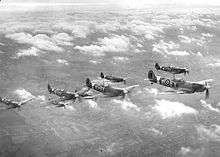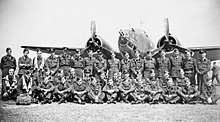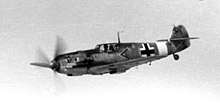Operation Ramrod 16
| Operation Ramrod 16 | |||||
|---|---|---|---|---|---|
| Part of the Second World War | |||||
 RAF Lockheed Ventura | |||||
| |||||
| Belligerents | |||||
|
|
| ||||
| Commanders and leaders | |||||
|
| |||||
| Strength | |||||
|
5 Spitfire Squadrons 12 Lockheed Ventura bombers manned by 48 crewmen | 70 fighter aircraft | ||||
| Casualties and losses | |||||
|
10 Venturas lost near the target, one more written off after landing. 28 aircrew killed, 12 taken PoW 1 Spitfire lost; pilot PoW | 1 Bf 109 lost | ||||
Operation Ramrod 16 was a daylight bombing raid undertaken by the RAF against the Hemweg Power Station in Amsterdam. The intention was to destroy the power station and entice the Luftwaffe up to engage the supporting Spitfires. Five squadrons of Spitfires were committed to the operation in support of one squadron of Lockheed Venturas. This type of heavily escorted bombing raid was called a Ramrod. They were a part of Fighter Command's Circus offensive. The raid was undertaken during the late afternoon of 3 May 1943.
Background
Bomber Command had withdrawn its aircraft from daylight attacks after suffering heavy losses attempting daylight bombing raids over France and the North Sea in the first half of 1940. Since that time Bomber Command operations against German industry were almost exclusively conducted under the cover of night.[1] However, the German war effort was being supported by factories in the occupied countries as well.[2] These targets presented a problem for Bomber Command. Bombing them at night would necessarily result in significant casualties amongst the civilians of the occupied country. To strike at such targets, Bomber Command had to attempt attacks in the light of day. They did so against selected targets throughout the course of the war.
Following their successful defense of British airspace in the Battle of Britain, RAF Fighter Command moved over onto the offensive and began sending fighter squadrons over northern France, Belgium and the Netherlands to engage and destroy the Luftwaffe.[3] The RAF called these missions Circuses, and they fell into three main types. Rodeos were large fighter sweeps. Rhubarbs were fighter sweeps on a small scale conducted below cloud. Ramrod raids involved a small bomber force accompanied by a large fighter escort. In response to these raids the Luftwaffe withdrew its squadrons from coastal airbases and moved their fighter forces inland, where they could engage or decline combat.[3] The Hemweg Power Station raid was the 16th Ramrod type mission, thus the operation was named Ramrod 16.

Planning

The bomber contingent for the Ramrod missions was provided by Bomber Command's No. 2 Group, whose squadrons were largely equipped with medium bombers for attacking targets across the channel, often in daylight. 487 (New Zealand) Squadron was given the task of providing 12 Ventura medium bombers for Operation Ramrod 16. They were to strike at the Hemweg Power Station at the northern end of Amsterdam. The plan was to launch the bombers late in the afternoon. They would cross the North Sea at 100 feet to stay below German radar until they were ten minutes from the Dutch coast, then climb suddenly to 10,000 feet and head straight for the target, hopefully with a degree of surprise. Crews were told to expect heavy opposition. Top cover was to be provided by two squadrons of Spitfire Mk IXs, while close support was to be provided by three squadrons of Spitfires Mk Vs. The instructions to the crews were to press home the attack, regardless of the opposition, as it was considered important for the morale of Dutch workers who were in their third year of Nazi occupation.[4]
The raid was planned so the light would be fading by the time of the attack, allowing the Venturas some measure of concealment with darkness during their return flight. The Venturas were led by Squadron Leader Leonard Trent.
The raid
The 12 Venturas took off from RAF Methwold at 16:43 in clear weather. Trent led the first six Venturas in a tight box formation, with a second group of six behind led by Flight Lieutenant Arthur Duffill. One of the aircraft in the lead flight had a mechanical problem with its escape hatch door and had to return to base.
Coordinating and maintaining a fighter escort was a difficult business, and failures to link up were not uncommon. In the case of Ramrod 16 the two squadrons of Spitfires designated to fly top cover left for the target early and climbed too soon, burning up their limited fuel and alerting the Germans to the approaching raid. Unable to await the bombers, they were recalled to base. To tip the odds further against the bomber force, as the 11 Venturas made their climb just before reaching the Dutch coast the close support Spitfires lost position and fell behind, with one of the three squadrons losing contact altogether.[4]
German opposition to the raid was greater than anticipated. In addition to the normal Luftwaffe presence, the day of the mission saw the Reichskommissar of the Netherlands, Arthur Seyss-Inquart, visit Haarlem, and a group of German fighters had come with him to provide air cover for his trip. Further, a Luftwaffe conference was being held that day at the Schiphol airfield near Amsterdam, and a great number of experienced Luftwaffe fighter pilots were present as well to attend the conference.[4]
When the Venturas reached the coast some 70 German fighters were airborne and had formed up into four formations to meet them. Intercepting the raiders at the coast, Fw 190s from 11/JG1 engaged the Spitfire escorts while Bf 109s of 2./JG27 closed with the bombers. The escorting Spitfires were overwhelmed and the Venturas were soon under attack. Duffill’s aircraft leading the second formation was one of the first to be knocked out of the battle. Cannon fire wounded two of his crew, cut the hydraulics and set both engines afire. Duffill dove to sea level to help put out the flames and turned back. In the next four minutes six more Venturas were shot up. Two crashed into the sea, three more were shot down after crossing the coast and the sixth dropped its bombs and turned back but was forced to ditch shortly after getting back over the ocean.

The four aircraft remaining continued on and were soon flying into intense anti-aircraft fire, while the Bf 109s still pursued them. One of the German fighters overflew the group and crossed before Trent, giving him a chance to fire at it with his fixed twin .303 nose guns. The Messerschmitt was caught in the short burst and was seen to go down. Trent later said he was surprised the German pilots would pursue them through such heavy flak. Approaching the target at 7,000 feet, Trent saw his wingman shot down, followed directly by the other two aircraft. Pressing on to the target, Trent released his bombs and turned for home, but as he did so his aircraft was hit hard, went into a sharp spin and broke apart. Trent and his navigator, Vivian Phillips, were thrown clear of the wreckage in midair and pulled their parachutes, but the other two crew members were unable to get free and died in the crash. Both Trent and his navigator survived and were taken prisoner.[5] The full story of what had transpired did not come out until they were repatriated.
Aftermath
Of the twelve aircraft 487 sent on the mission, only two survived. One was the Ventura from the first box which had to turn back with a malfunctioning escape hatch. The hatch broke free completely when the plane came in to land and ended up jammed in the airplane's rudder. The other was Diffill’s shot up aircraft from the second box. Diffill was able to get his airplane back to base, but the plane was a write off. After the mission 487 Squadron could muster only 6 crews and 8 aircraft. King George VI soon came to RAF Methwold to pay his respects to the New Zealand squadron that had been nearly wiped out pressing home their attack.

At the end of May 2 Group left Bomber Command to join the new Second Tactical Air Force, and came under Fighter Command control until the formation of the Allied Expeditionary Air Force five months later. In August 487 Squadron converted to the de Havilland Mosquito.[4] On the conversion from the Ventura to the Mosquito, Pilot Officer Maxwell Sparks offered: "The difference was the difference between Delboy's Three-wheeler and a F-1 Grand Prix racecar."[6] The squadron was made a part of the newly formed 140 Wing and went on to participate in the Amiens prison raid.
Leonard Trent was interned at Stalag Luft III in Sagan, in Lower Silesia, Germany. He was one of 76 escapees that broke from the prison camp in what became known as "The Great Escape". The last man out of the tunnel, Trent had crossed the clearing and just reached the edge of the woods when he was caught in the camp searchlights. He stood up rather than be shot and was immediately taken back into custody. He was passed over when the Gestapo set about selecting 50 recaptured escapees to be executed. Instead, he was sent to another prison camp where he remained until the camp was liberated 2 May 1945.
Following his repatriation Trent returned to his squadron and the details of what had happened on the raid became known.[7] For their actions during Operation Ramrod 16 navigator Phillips was awarded the DSO.[8] Trent was awarded the Victoria Cross.[9] His investiture at Buckingham Palace took place on 12 April 1946. Following the war he spent a short amount of time in the New Zealand Air Force before returning to the RAF. He completed his career there, reaching the rank of Group Captain.[4]
See also
References
- Citations
- ↑ Maynard 1996, pp. 22-23.
- ↑ Klemann and Kudryashov 2013.
- 1 2 Murray 1989, p. 128.
- 1 2 3 4 5 "Trent Leonard". Aircrew Remembered. Retrieved 11 February 2018.
- ↑ Ashworth 1995, p. 78.
- ↑ Shaw, Martin (23 October 2011). "Operation Jericho". BBC. Retrieved 1 August 2017.
- ↑ "3rd May 1943 No 487 Squadron RNZAF Wiped-out in Daylight Raid". WW@ Today. Retrieved 11 February 2018.
- ↑ "London Gazette" (PDF). 5 March 1946. Retrieved 11 February 2018.
- ↑ "London Gazette" (PDF). 1 March 1946. Retrieved 11 February 2018.
- Bibliography
- True to the End Pacific Wings Magazine, January 2001
- Ashworth, Chris RAF Bomber Command 1936-1968 Somerset, UK: Haynes Publishing (1995). ISBN 1 85260 308 9
- Klemann, Hein A M and Sergei Kudryashov Occupied Economies: An Economic History of Nazi-Occupied Europe, 1939-1945 London : Berg Publishers, 2013.
- Maynard, John Bennett and the pathfinders London: Arms and Armour, (1996).
- Murray, Williamson Strategy for defeat: the Luftwaffe, 1933-1945 Maxwell Air Force Base, Ala. : Air University Press, (1989)[1983]. ISBN 978 0 933852 45 7.
